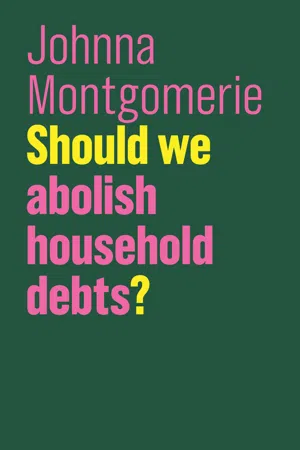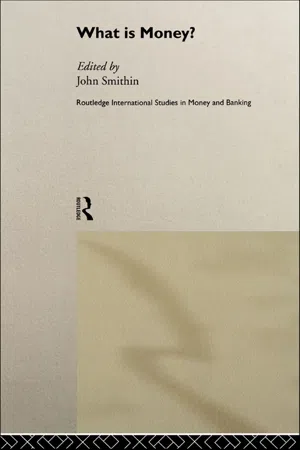Credit Creation
Credit creation refers to the process by which banks and financial institutions generate new money through the extension of loans and credit. When a bank issues a loan, it effectively creates new money in the economy, as the borrower can then use these funds to make purchases and investments. This process plays a crucial role in expanding the money supply and stimulating economic activity.
5 Key excerpts on "Credit Creation"
- eBook - ePub
- Joseph A. Schumpeter(Author)
- 2021(Publication Date)
- Routledge(Publisher)
...But this is in the first place not necessary and in the second place does not alter the nature of the process, which consists in creating a new demand for, without simultaneously creating, a new supply of goods. This thesis needs no further proof here, but follows from the arguments of the second chapter. It provides us with the connection between lending and credit means of payment, and leads us to what I regard as the nature of the credit phenomenon. Since credit in the one case in which it is essential to the economic process can only be granted from such newly created means of payment (provided there are no results of previous development); and since, conversely, only in this one case does the creation of such credit means of payment play more than a merely technical role, then to this extent giving credit involves creating purchasing power, and newly created purchasing power is of use only in giving credit to the entrepreneur, is necessary for this purpose alone. This is the only case in which we cannot, without impairing the truth of our theoretical picture, substitute metal money for credit means of payment. For we can assume that a certain quantity of metal money exists at any time, since nothing depends upon its absolute magnitude; but we cannot assume an increase of it to appear just at the right time and place. Therefore if we exclude from lending as well as from the creation of credit instruments those cases in which credit transactions and credit instruments play no essential part, then the two must coincide, if we neglect the results of previous development. In this sense, therefore, we define the kernel of the credit phenomenon in the following manner: credit is essentially the creation of purchasing power for the purpose of transferring it to the entrepreneur, but not simply the transfer of existing purchasing power...
- eBook - ePub
- Johnna Montgomerie(Author)
- 2019(Publication Date)
- Polity(Publisher)
...If credit is to be an economic utility, the moral economy of debt must recognize that credit is made at the stroke of a keyboard. If credit is that easy to create, then it can be eliminated equally easily. Banks have a licence to print digital money, which becomes revenue streams in the economy through consumption; but credit contracts, too, are commodities traded many times over on global markets. If too much debt is causing wider economic problems and creating harm in society, then cancelling the existing debts is the only way to end it. The credit irrigation system needs to be redesigned in order to ensure that the ‘unconventional’ measures taken by the central bank reach households and small businesses; and, by doing so, it would also ensure that publicly subsidized credit is playing a useful role in the economy and betters society....
- eBook - ePub
- Joseph A Schumpeter(Author)
- 2017(Publication Date)
- Routledge(Publisher)
...It can indeed be covered by other assets than products, that is by any kind of property which the entrepreneur may happen to own. But this is in the first place not necessary and in the second place does not alter the nature of the process, which consists in creating a new demand for, without simultaneously creating, a new supply of goods. This thesis needs no further proof here, but follows from the arguments of the second chapter. It provides us with the connection between lending and credit means of payment, and leads us to what I regard as the nature of the credit phenomenon. Since credit in the one case in which it is essential to the economic process can only be granted from such newly created means of payment (provided there are no results of previous development) ; and since, conversely, only in this one case does the creation of such credit means of payment play more than a merely technical rôle, then to this extent giving credit involves creating purchasing power, and newly created purchasing power is of use only in giving credit to the entrepreneur, is necessary for this purpose alone. This is the only case in which we cannot, without impairing the truth of our theoretical picture, substitute metal money for credit means of payment. For we can assume that a certain quantity of metal money exists at any time, since nothing depends upon its absolute magnitude; but we cannot assume an increase of it to appear just at the right time and place. Therefore if we exclude from lending as well as from the creation of credit instruments those cases in which credit transactions and credit instruments play no essential part, then the two must coincide, if we neglect the results of previous development. In this sense, therefore, we define the kernel of the credit phenomenon in the following manner: credit is essentially the creation of purchasing power for the purpose of transferring it to the entrepreneur, but not simply the transfer of existing purchasing power...
- eBook - ePub
- John Smithin, John Smithin(Authors)
- 2002(Publication Date)
- Routledge(Publisher)
...In this process, the sellers of both sectors realize their money profits and the monetary circuit is now completed with the flux matching the reflux of credit money. All profits are now used to repay the loans which had been the prior source of investment finance and, at the same time, the credit money originally created is extinguished. It is, in part, for this reason that we reject the view put forth by Nell (1998) who has argued that, in order to minimize transaction and borrowing costs, and thereby the number of transactions in a production economy, the optimal quantity of credit money ought to be just equal to the wages paid in the equipment goods sector. Nell’s view, which is based on the principle of cost minimization as well as on a peculiar notion of money, would perhaps also succumb to further criticism (which we discuss in a separate section) of the neoclassical conception of money. Since loans are granted to firms by commercial banks chartered by the state, their own creditworthiness will ultimately depend on their ability to earn profits out of their credit-creating activity. In the long run, the existence of money requires that bank profits generate enough equity value to match the value of assets sustained by banks’ own desired monetary markup. Consequently, we can spell out this stability condition for the monetary system: The rate of interest charged on credit advances, which is the primary source of bank profits, must be high enough to support an amount of bank equity equal to that generated by bank assets resulting from the monetary mark-up imposed on firms. From this, there ensues the concept of exogeneity of the rate of interest. By its nature, the rate is imposed by banks on firms and it can be included as part of the creditworthiness rules to which firms have to comply. There has been some discussion in the heterodox literature on the capacity of firms to pay interest to banks (Leonard 1987)...
- eBook - ePub
- John Roscoe Turner(Author)
- 2019(Publication Date)
- Routledge(Publisher)
...So their cash reserves are reduced to a minimum; they resort to credit and trust to luck that they will get more money somehow when it is needed. Provident persons starting into business or desiring to enlarge operations will have little money in reserve. The need of funds to construct large productive establishments may require more money than is in circulation. This necessity, whether for purposes of consumption or of production, will lead to the establishment of a credit system which shall serve the place of money. 3. Credit Defined. What has been said indidates that credit is a readily acceptable thing, which performs the essential function of money, but it has a broader application. If we speak of the public credit of Mexico, we have in mind the ability and readiness of that government to fulfil its pecuniary obligations. Credit is trust given or received; expectation of future payment for property transferred or promises given; it applies to individuals, corporations, and nations. Credit is used at times to signify a person's ability to contract a debt. "A good pay is master of another man's purse." "A good way to make debts is to pay them." William Roscher, a German economist, said: "Credit is the power of disposition over the goods of another, voluntarily granted in consideration of the mere promise of the counter-value." A more accurate statement is that credit refers to the obligation which exists between a debtor and a creditor during the interval of time between the two parts of a complete act of exchange...




